Failure Mechanism and Stability Control of Soft Roof in Advance Support Section of Mining Face
Abstract
1. Introduction
2. Failure Mechanism of Surrounding Rock of Roadway at ASSoMF
2.1. Background of Lijiahao Coal Mine
2.2. Construction and Excavation of Numerical Simulation Model
2.3. Regional Stress Distribution Law of Mining Roadway
2.4. Space-Time Evolution Law of Surrounding Rock Plastic Zone
2.5. Failure Mechanism of Surrounding Rock in Non-Uniform Stress Field
- where
- where a is the roadway radius, P is the minimum principal stress, , are the cohesive force and friction angle, respectively, and R is the radial plastic zone boundary of the roadway-surrounding rock.

3. Stability Control of Roof Surrounding Rock at ASSoMF
3.1. Current Situation of Advance Support Technology
3.2. Control Analysis of Support Resistance on Surrounding Rock Plastic Zone
3.3. Advance Support Principle of Mining Face
4. Advance Support Equipment without Repeated Support for Mechanized Movement
4.1. Characteristics of the Equipment
4.2. Analysis of Support Opportunity
4.3. Stability Analysis the Equipment
5. Conclusions
Author Contributions
Funding
Data Availability Statement
Conflicts of Interest
References
- Esterhuizen, G.S.; Gearhart, D.F.; Klemetti, T.; Dougherty, H.; Van Dyke, M. Analysis of gateroad stability at two longwall mines based on field monitoring results and numerical model analysis. Int. J. Min. Sci. Technol. 2019, 29, 37–45. [Google Scholar] [CrossRef]
- Xu, Y.J.; Zhang, K.; Li, D.Y.; Zhang, D.S. Theory and application of self-adaptive support for advanced powered support. J. China Coal Soc. 2020, 45, 3615–3624. [Google Scholar] [CrossRef]
- Cai, M.F. Key theories and technonogies for surrounding rock stability and ground control in deep mining. J. Min. Strat. Control. Eng. 2020, 2, 5–13. [Google Scholar] [CrossRef]
- Esterhuizen, G.S.; Tulu, I.B.; Gearhart, D.F.; Dougherty, H.; Van Dyke, M. Assessing support alternatives for longwall gateroads subject to changing stress. Int. J. Min. Sci. Technol. 2020, 31, 103–110. [Google Scholar] [CrossRef]
- Zhu, J.F.; Yin, Q.; Zhang, J.M.; Jing, H.W. Deformation evolution and asymmetric support of deep-buried surrounding rock mass with a gently inclined weak interlayer. J. Min. Strat. Control. Eng. 2022, 4, 47–61. [Google Scholar] [CrossRef]
- Liu, H.S.; Luan, H.J.; Qiao, J.L.; Li, G.F.; Zhang, S.H. Failure mechanism and strengthening support technology of gangue-containing coal roadway sidewall. J. Min. Strat. Control. Eng. 2022, 4, 38–49. [Google Scholar] [CrossRef]
- Sasaoka, T.; Mao, P.; Shimada, H.; Hamanaka, A.; Oya, J. Numerical analysis of longwall gate-entry stability under weak geological condition: A case study of an indonesian coal mine. Energies 2020, 13, 4710. [Google Scholar] [CrossRef]
- Duan, C.R.; Zheng, Q.; Xue, J.H.; Yu, G.F.; Luo, Y. Experimental study on zonal failure discontinuous deformation of deep surrounding rock under different working conditions. J. Min. Strat. Control. Eng. 2021, 3, 76–84. [Google Scholar] [CrossRef]
- Kong, H.P. Spatial scale analysis on coal mining and strata control technologies. J. Min. Strat. Control. Eng. 2020, 2, 5–30. [Google Scholar] [CrossRef]
- Mao, P.; Shimada, H.; Hamanaka, A.; Wahyudi, S.; Oya, J.; Naung, N. Three-dimensional analysis of gate-entry stability in multiple seams longwall coal mine under weak rock conditions. Earth Sci. Res. J. 2020, 9, 1. [Google Scholar] [CrossRef]
- Guo, J.S. Selection design and outlook on advanced hydraulic powered support of gateway in fully-mechanized coal mining face. Coal Sci. Tech. 2016, 44, 30–35. [Google Scholar] [CrossRef]
- Zhang, N.; Han, C.L.; Xie, Z.Z. Theory of continuous beam control and high efficiency supporting technologyin coal roadway. J. Min. Strat. Control. Eng. 2019, 1, 48–55. [Google Scholar] [CrossRef]
- Li, J.; Lian, X.Y.; Li, C.; Wu, Z.; Wang, J. Failure mechanism and support system of roofs in advance areas affected by mining under the condition of soft rock stratum. Front. Earth Sci. 2022, 10, 1–15. [Google Scholar] [CrossRef]
- Kang, H.P.; Jiang, P.F.; Wu, Y.Z.; Gao, F.Q. A combined “ground support-rock modification-destressing” strategy for 1000-m deep roadways in extreme squeezing ground condition. Int. J. Rock Mech. Min. 2021, 142, 1–12. [Google Scholar] [CrossRef]
- Pan, Y.S.; Gao, X.P.; Wang, W.; Xiao, Y.H. Research of hydraulic powered supports for entries’ advanced support in fully mechanized working face of rock burst mine. Coal Sci. Tech. 2021, 49, 1–12. [Google Scholar] [CrossRef]
- Jiang, L.; Kong, P.; Shu, J.; Fan, K. Numerical analysis of support designs based on a case study of a longwall entry. Rock Mech. Rock. Eng. 2019, 52, 3373–3384. [Google Scholar] [CrossRef]
- Pan, Y.S.; Xiao, Y.H.; Li, G.Z. Roadway hydraulic support for rockburst prevention in coal mine and its application. J. China Coal Soc. 2020, 45, 90–99. [Google Scholar] [CrossRef]
- Guo, N. Research on Advance Stress Distribution Law of Thick Hard Roof and Optimization of Advance Support Technology. Master’s Thesis, China University of Mining and Technology, Xuzhou, China, 2021. [Google Scholar] [CrossRef]
- Cai, L. The Coupling Mechanism and Application of Advanced Support-Anchorage Surrounding Rock in Fully Mechanized Coal Face. Master’s Thesis, China University of Mining and Technology, Xuzhou, China, 2018. [Google Scholar]
- Yao, Q.L.; Wang, H.H.; Xia, Z.; Li, L.H.; Zhu, L.; Li, X.H. Key technology and application of active fore poling for longwall coal mining in coal mine. J. Min. Safety Eng. 2020, 37, 289–297. [Google Scholar] [CrossRef]
- Yao, Q.L.; Li, Y.H.; Xia, Z.; Li, X.H.; Wang, H.H.; Chao, N. Theory and application of roof superimposed beam support of coal roadway based on effective anchorage layer thickness. J. China Coal Soc. 2022, 47, 672–682. [Google Scholar] [CrossRef]
- Zhou, L. Application Study of Active Advanced Support in Longwall Mining. Master’s Thesis, China University of Mining and Technology, Xuzhou, China, 2021. [Google Scholar] [CrossRef]
- Zhao, S.R. Study on Non-Isometric Support Characteristics of Advanced Hydraulic Support Bracket Partition. Master’s Thesis, Liaoning Technical University, Fuxing, China, 2021. [Google Scholar] [CrossRef]
- Lai, H.C. Research on Supporting Features and Strength of Fully Mechanized Face Advanced Hydraulic Support. Master’s Thesis, Liaoning Technical University, Fuxing, China, 2019. [Google Scholar] [CrossRef]
- Ma, M.; Guo, Q.; Pan, J.; Ma, C.; Cai, M. Optimal support solution for a soft rock roadway based on the drucker–prager yield criteria. Minerals 2022, 12, 1. [Google Scholar] [CrossRef]
- Wang, F.; Wu, C.; Yao, Q.; Li, X.; Chen, S.; Li, Y.; Li, H.; Zhu, G. Instability mechanism and control method of surrounding rock of water-rich roadway roof. Minerals 2022, 12, 1587. [Google Scholar] [CrossRef]
- Zhang, K.; Li, Y.X.; Zhong, D.H.; Meng, X.J.; Huang, Q.X.; Xu, Y.J.; Chen, H.Y.; Ma, Y.; Zhang, D.S.; Huang, L.S.; et al. Research and experimental verification of mechanical characteristics of advanced hydraulic support group-anchor coupling support. Chin. J. Rock Mech. Eng. 2021, 40, 1428–1443. [Google Scholar] [CrossRef]
- Xu, Y.J.; Zhang, D.S.; Li, D.Y. Study on advanced powered support with omni-directional walking function. Coal Sci. Tech. 2019, 47, 161–166. [Google Scholar] [CrossRef]
- Wang, Q.; Wang, B.K.; Zheng, Y. Research and application of alternate circulation advance support technology for mining entry. J. Min. Safety Eng. 2022, 39, 750–760. [Google Scholar] [CrossRef]
- Itasca Consulting Group Inc. Itasca’s FLAC3D Documentation; Itasca Consulting Group Inc.: Minneapolis, MN, USA, 2022. [Google Scholar]
- Guo, X.F.; Zhao, Z.Q.; Gao, X.; Wu, X.Y.; Ma, N.J. Analytical solutions for characteristic radii of circular roadway surrounding rock plastic zone and their application. Int. J. Min. Sci. Technol. 2019, 29, 263–272. [Google Scholar] [CrossRef]
- Li, C.; Wu, Z.; Zhang, W.L.; Sun, Y.H.; Zhu, C.; Zhang, X.H. A case study on asymmetric deformation mechanism of the reserved roadway under mining influences and its control techniques. Geomech. Eng. 2020, 22, 449–460. [Google Scholar] [CrossRef]
- Xue, G.H.; Guan, J.; Cheng, J.J.; Zhang, H.; Ji, W.L.; Jing, X.P.; Wu, M. Design of advance support for deep fully-mechanized heading roadway and its support performance analysis. Coal Sci. Tech. 2018, 46, 15–20. [Google Scholar] [CrossRef]
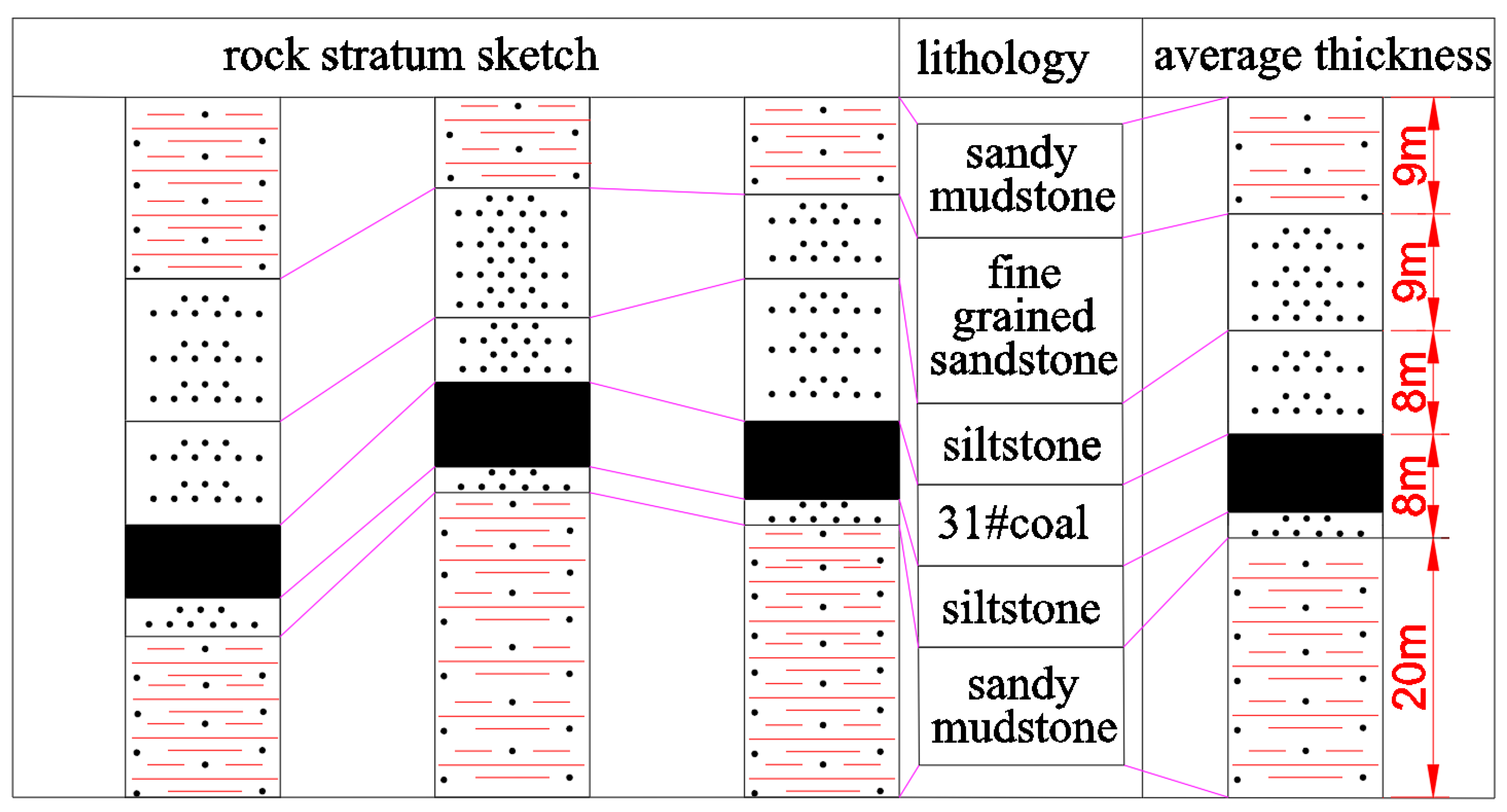


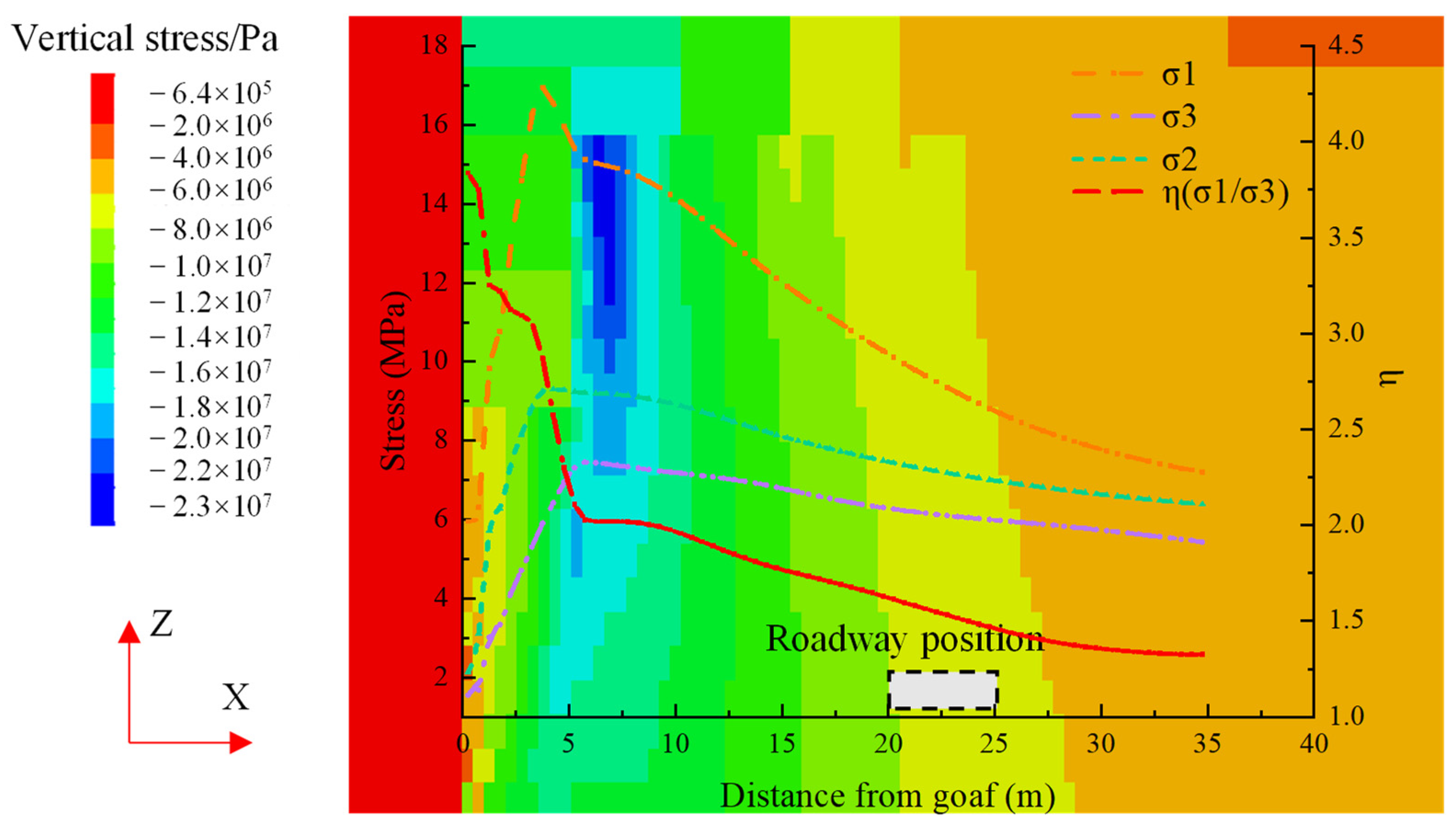
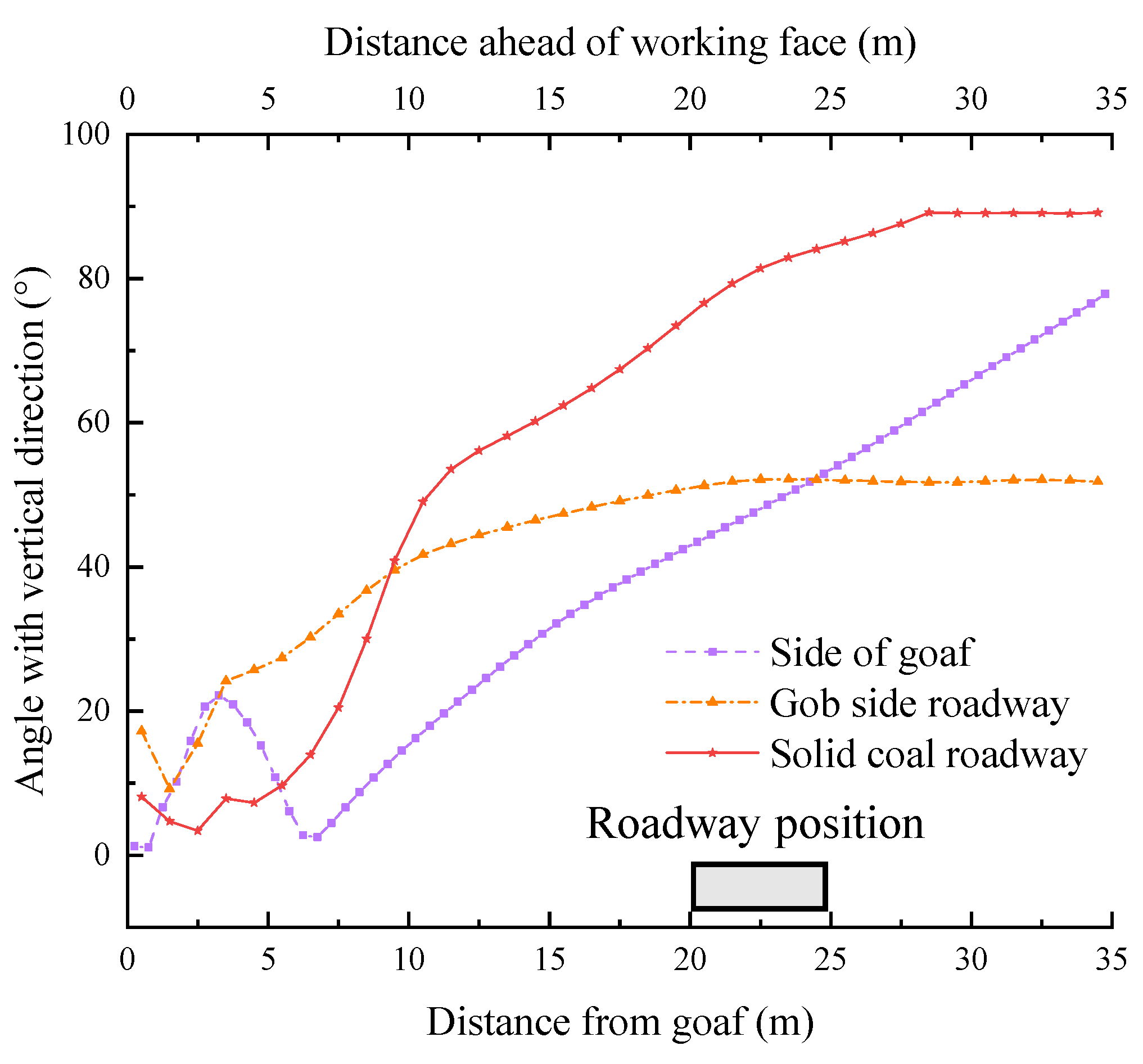
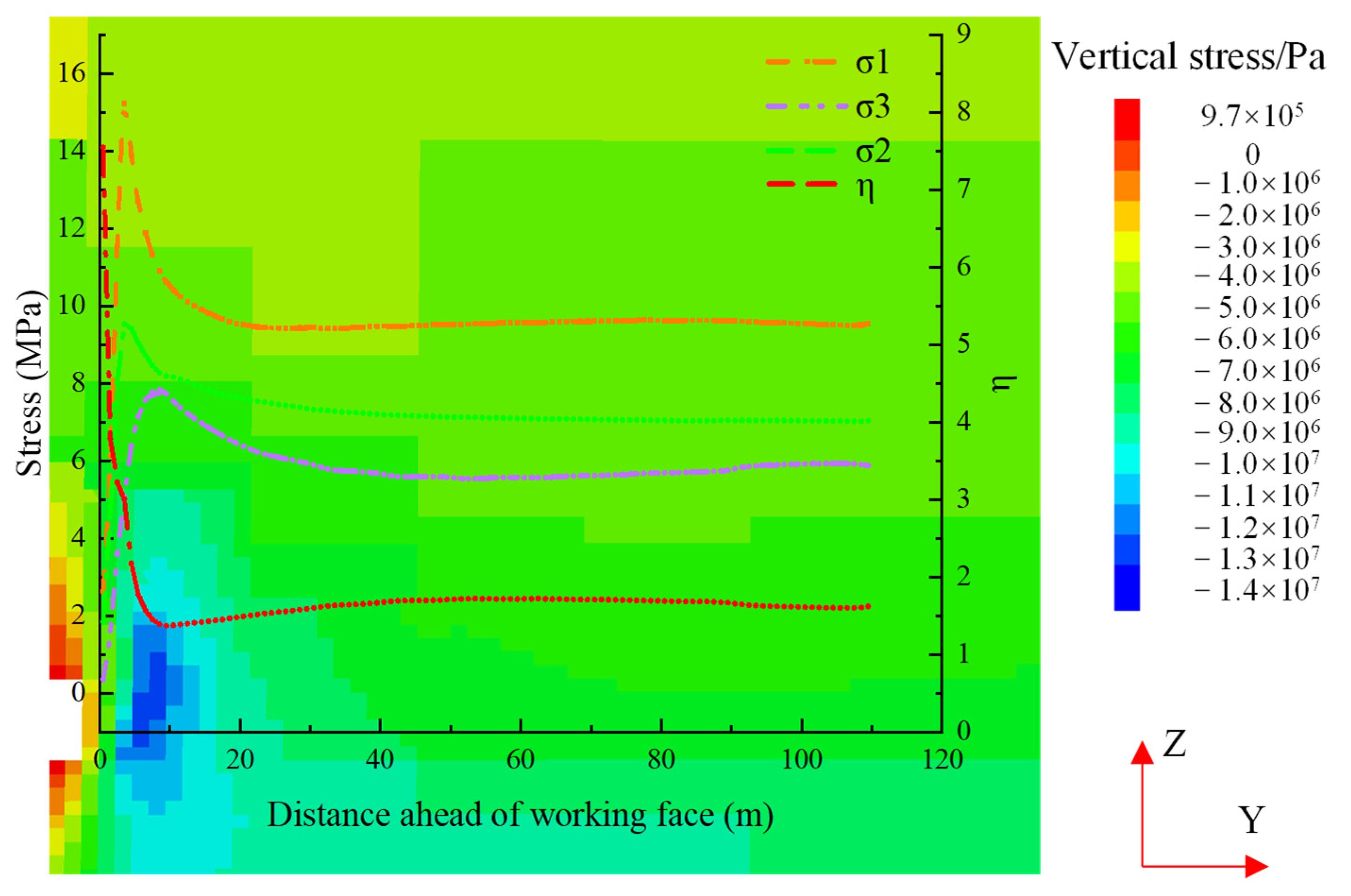


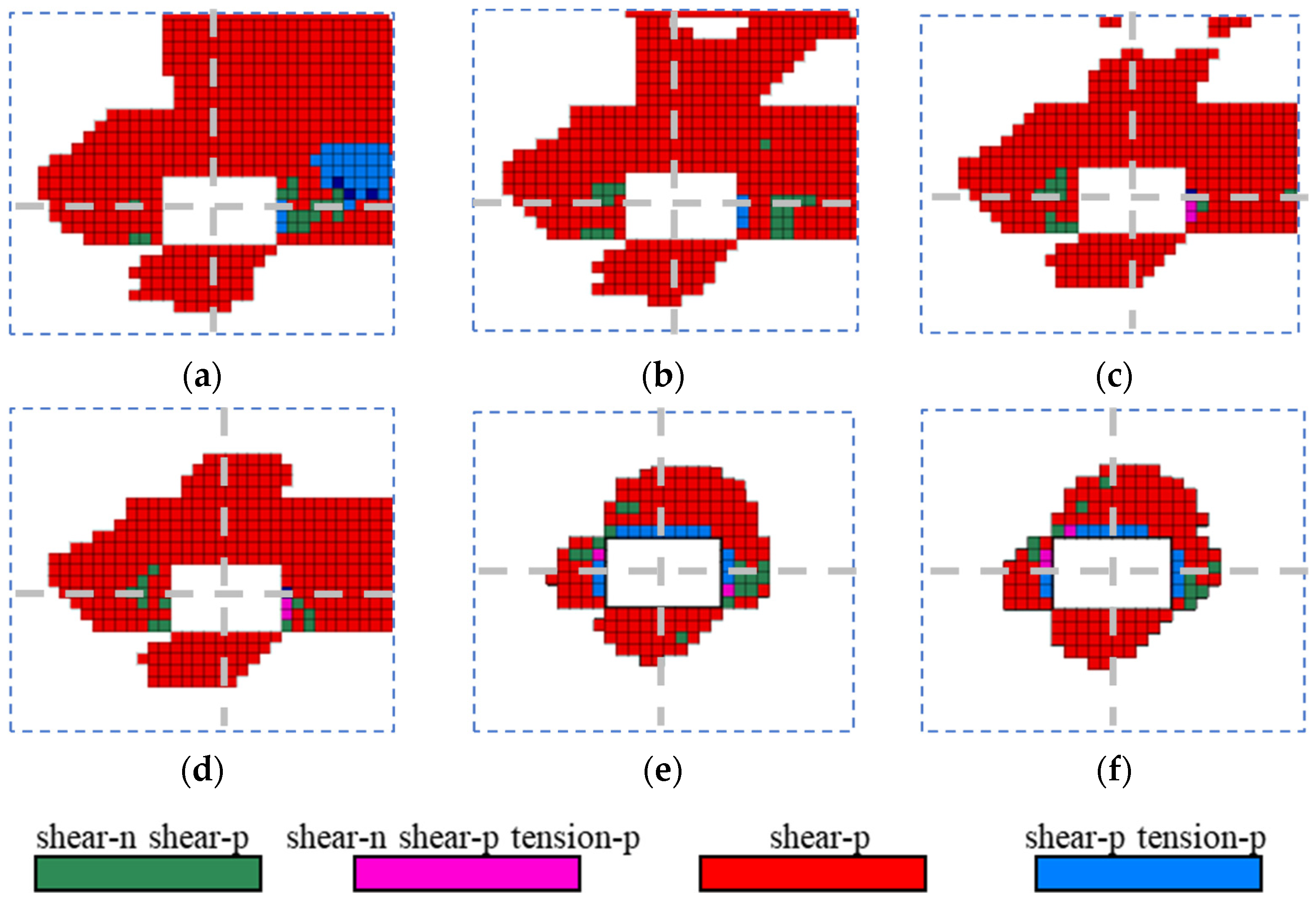
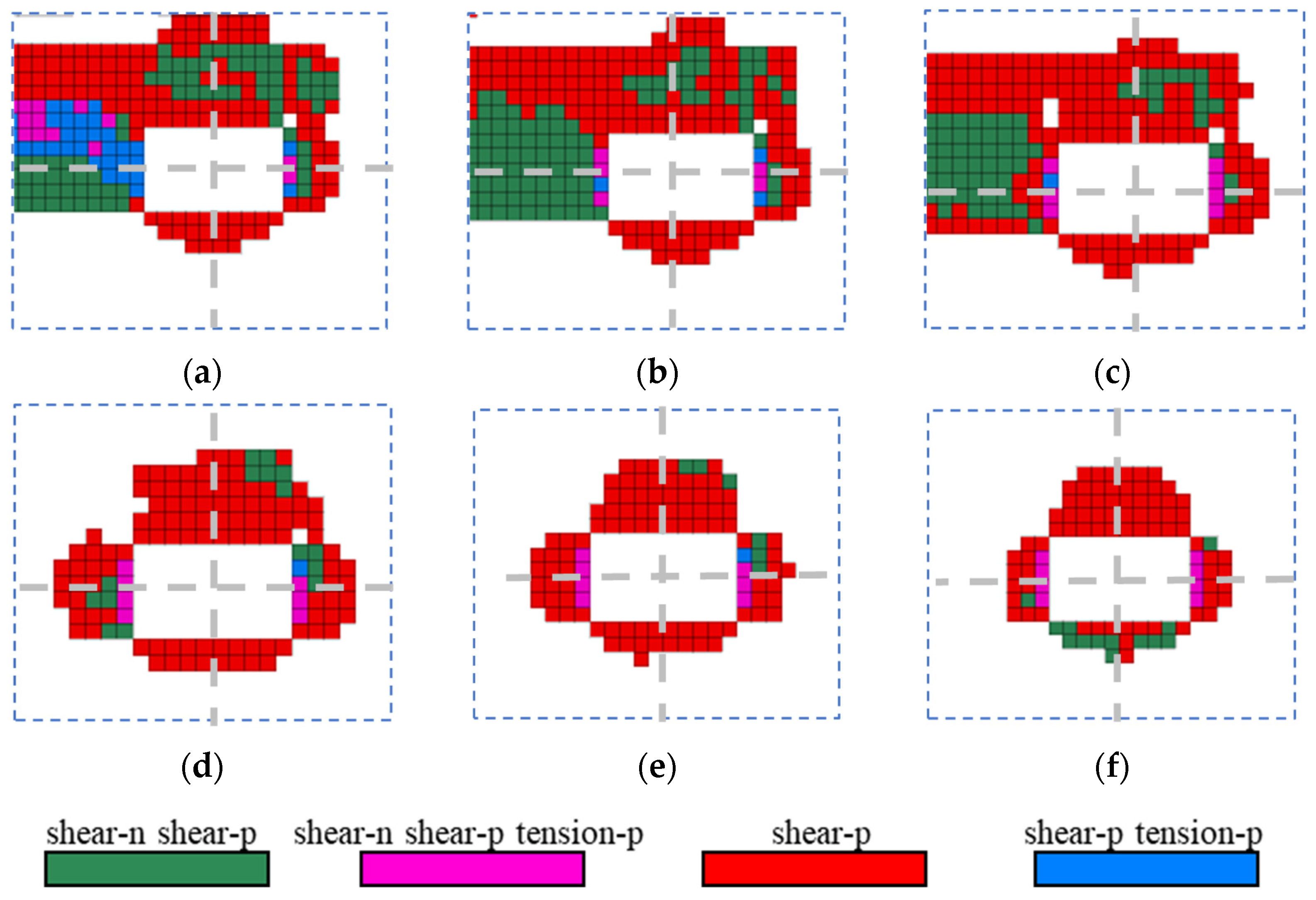

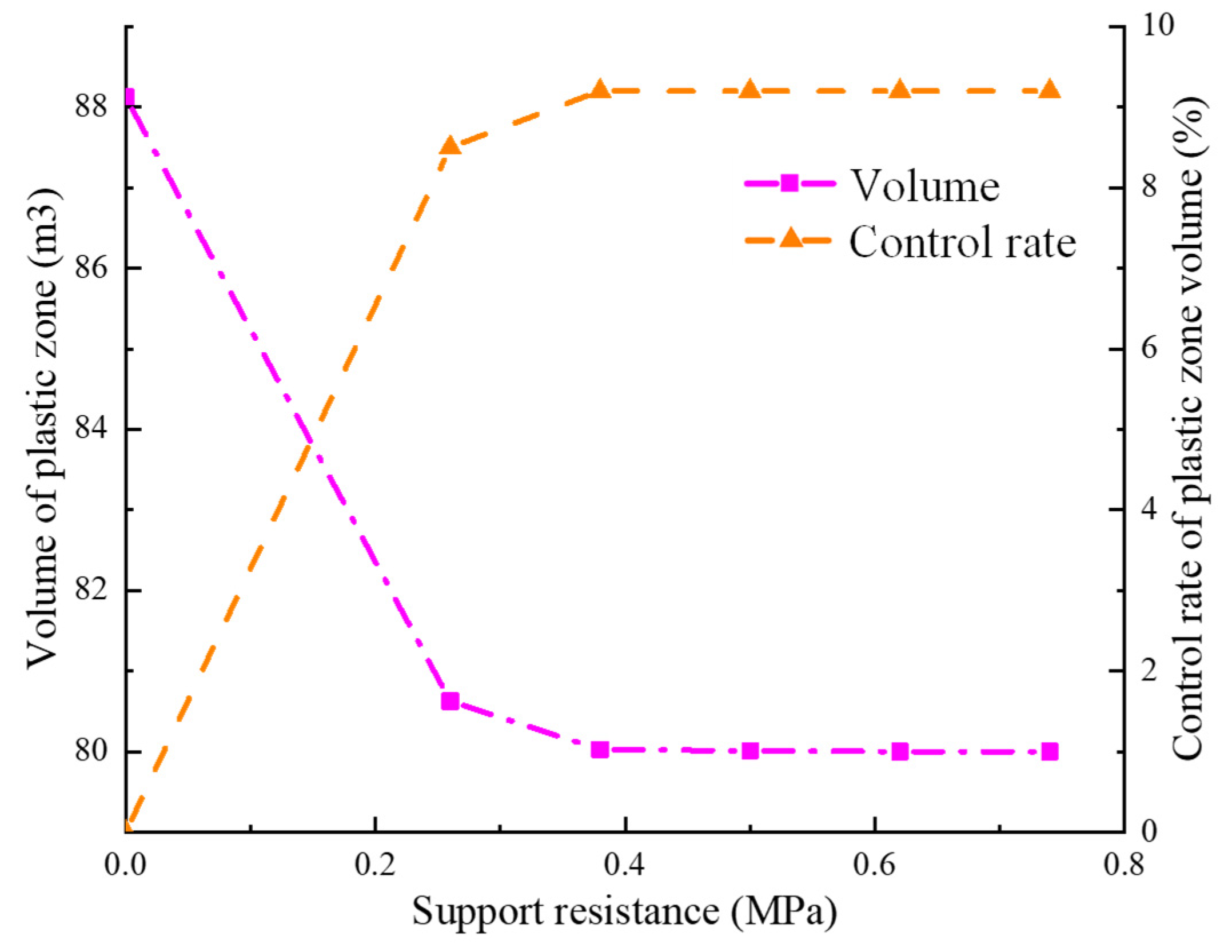
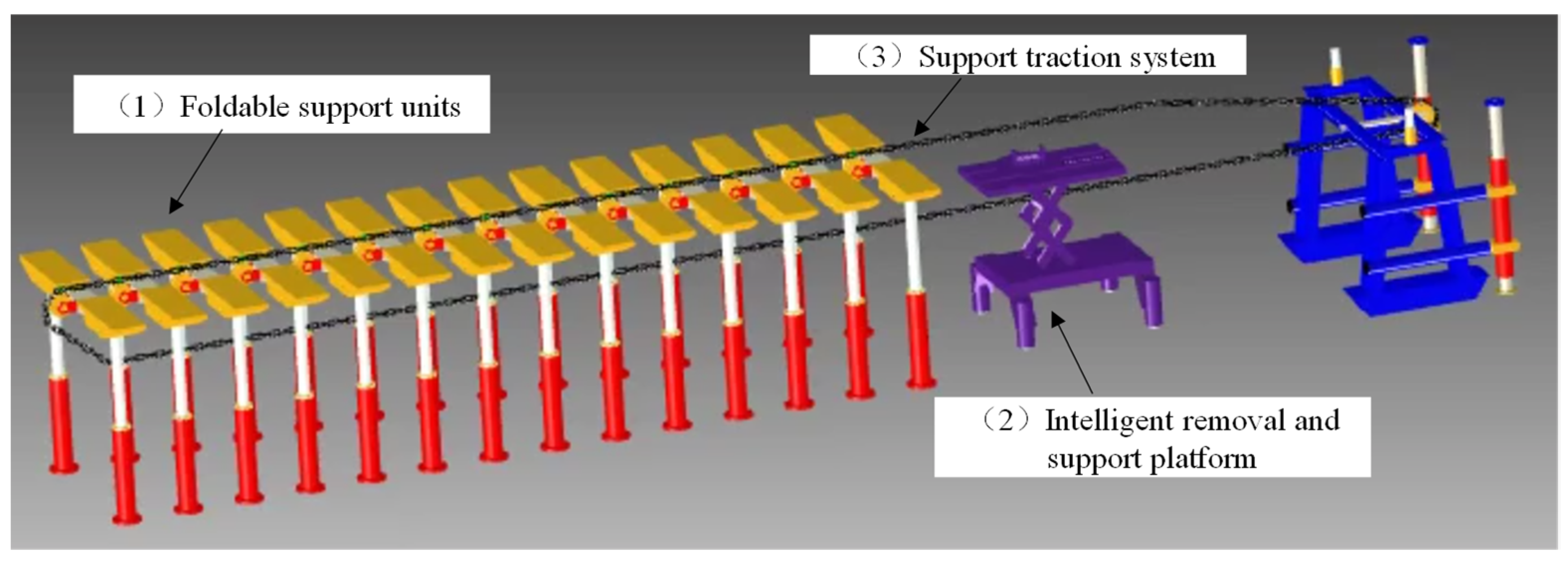
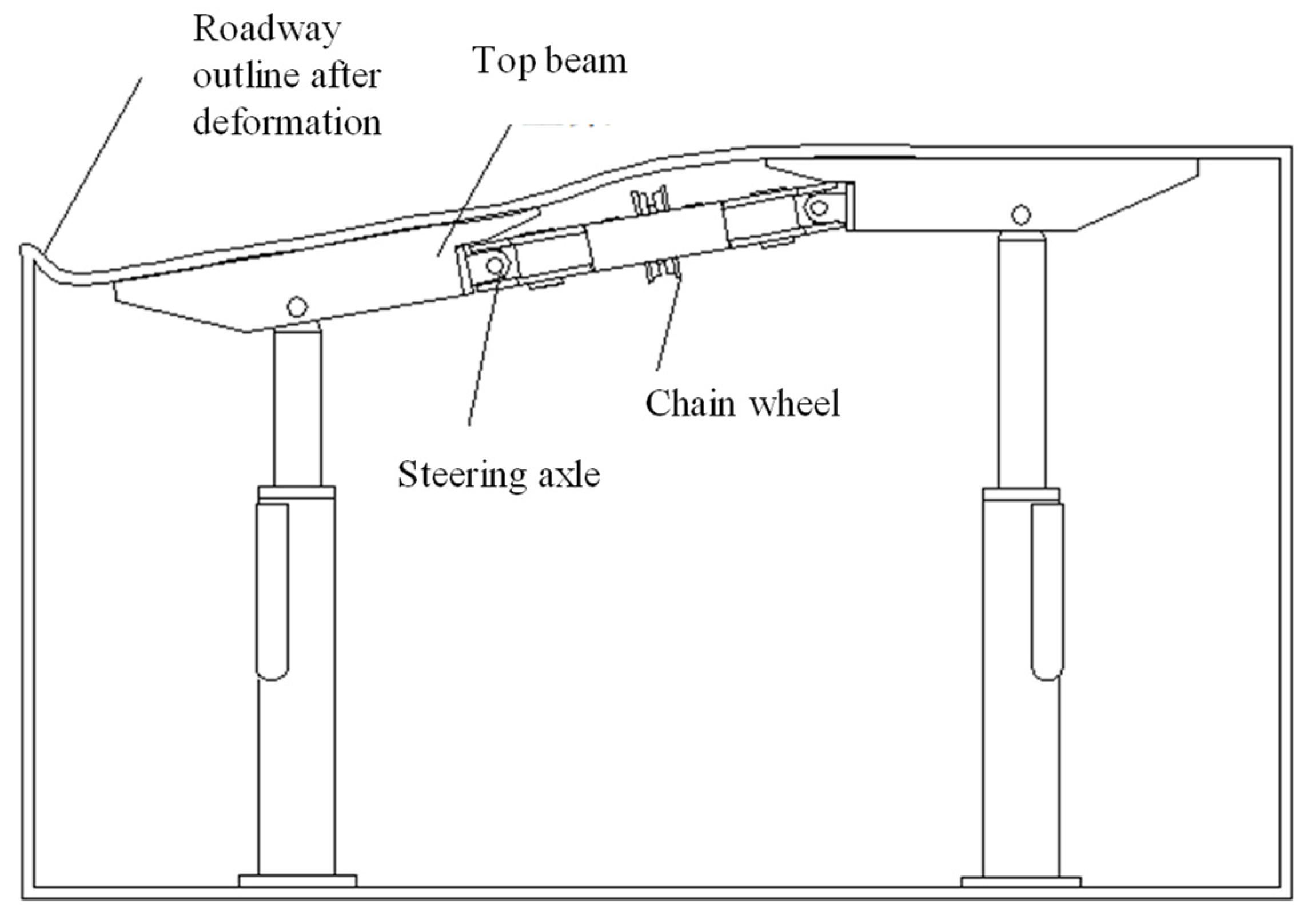
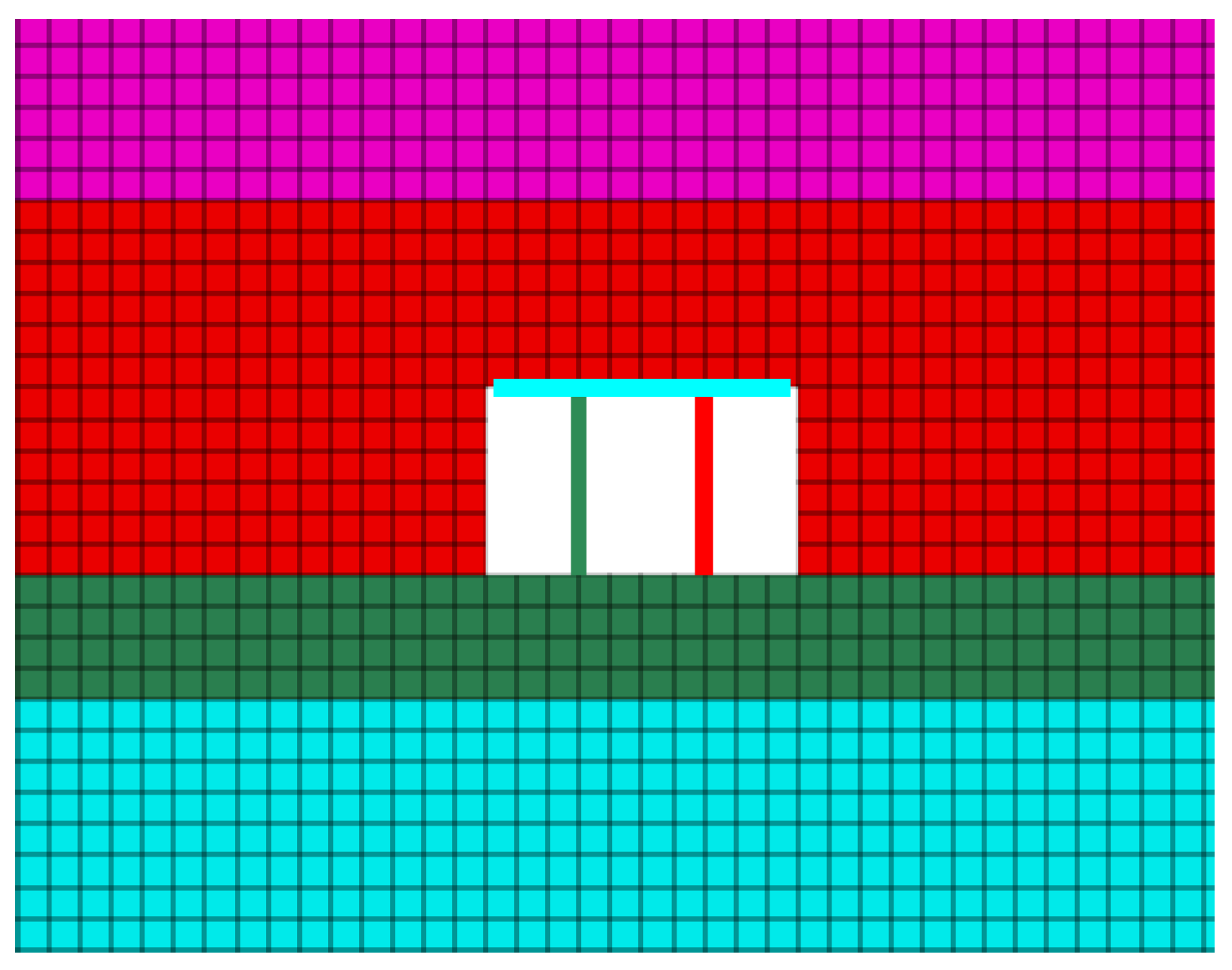
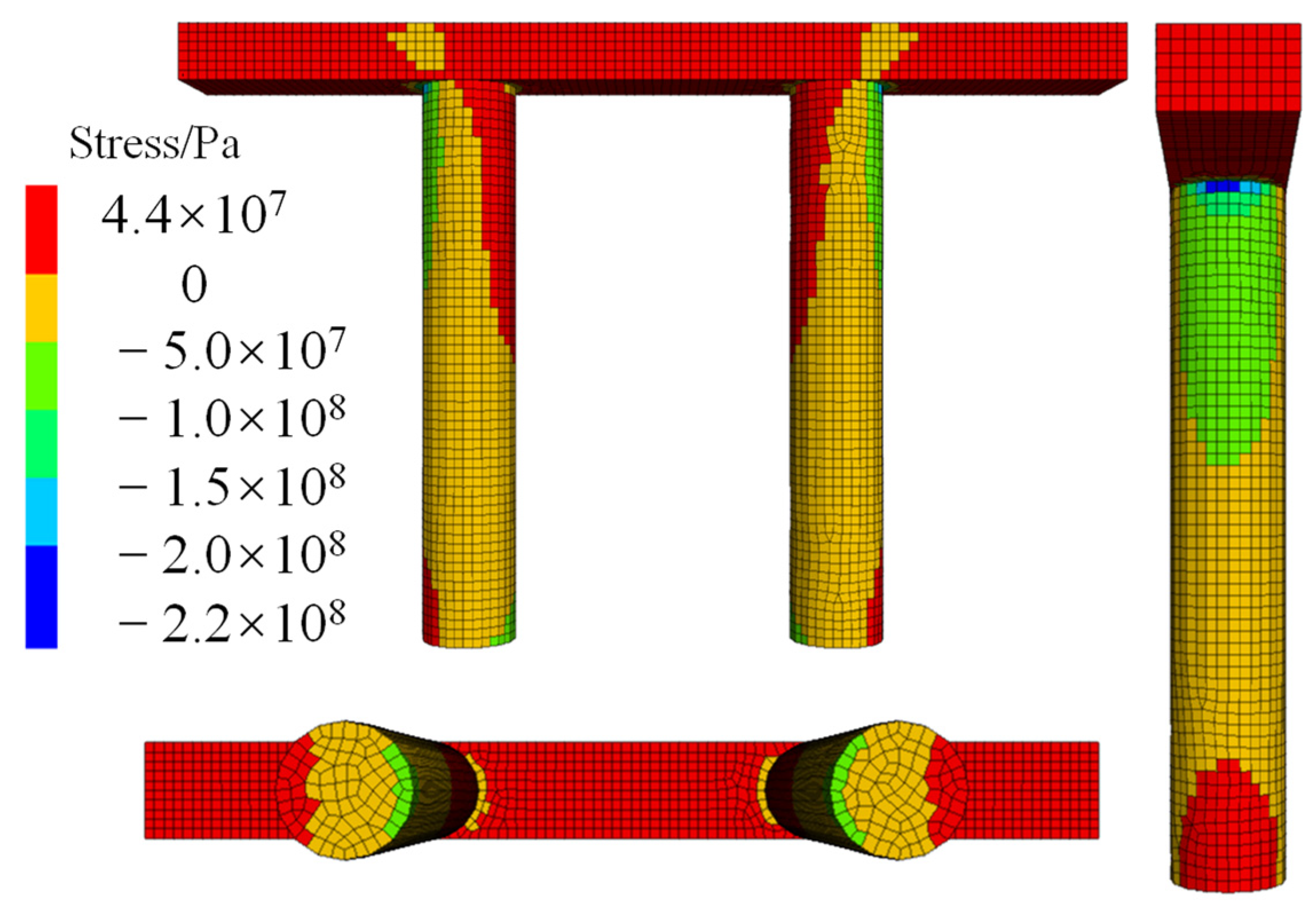
| Density (kg/m3) | Bulk Modulus ×103 (MPa) | Shear Modulus ×103 (MPa) | Friction Angle (°) | Dilation Angle (°) |
|---|---|---|---|---|
| 1750 | 5.5 | 4.6 | 20 | 7 |
| Lithology | Density (kg/m3) | Bulk Modulus ×103 (MPa) | Shear Modulus ×103 (MPa) | Friction Angle (°) | Cohesion (MPa) | Tensile Strength (MPa) |
|---|---|---|---|---|---|---|
| Sandy mudstone 2 | 2200 | 2.7 | 1.6 | 29 | 1.2 | 1.06 |
| Fine-grained sandstone | 2600 | 4.5 | 2.8 | 31 | 5.6 | 2.1 |
| Silt stone 2 | 2400 | 3.2 | 2.6 | 27 | 1.4 | 1.3 |
| Coal | 1350 | 2.5 | 1.2 | 28 | 0.9 | 0.6 |
| Silt stone 1 | 2400 | 3.6 | 2.6 | 32 | 1.6 | 1.3 |
| Sandy mudstone 1 | 2400 | 3.8 | 1.8 | 28 | 1.6 | 1.2 |
| Mine Name | Working Face | Mining Height | Burial Depth | Advance Support Technology |
|---|---|---|---|---|
| Ulan Mulun | 12405 | 2.5~3 m | 140 m | HR: reinforcement cable; VR: advance hydraulic support |
| Ulan Mulun | 31411 | 3.8 m | 170 m | Single-prop support |
| Liuta | 22102 | 3 m | 110 m | HR: single-prop support; VR: advance hydraulic support |
| Shigetai | 22201 | 1.9 m | 80 m | HR: reinforcement cable; VR: single-prop support |
| 31307 | 3.6 | 100 m | HR: reinforcement cable; VR: advance hydraulic support | |
| Cuncaota No. 2 Mine | 31205 | 3.6 m | 310 m | HR: single-prop support; VR: advance hydraulic support |
| Halagou | 22521 | 4.6 m | 60 m | Advance hydraulic support |
| Shangwan | 22104 | 6.5 m | 120 m | Advance hydraulic support |
| Bulianta | 22408 | 6.5 m | 250 m | HR: reinforcement cable; VR: advance hydraulic support |
| Daliuta | 52502 | 6.8 m | 170 m | Advance hydraulic support |
| Yujialiang | 52209 | 4.2 m | 100 m | Single-prop support |
| Baode | 81308 | Ming 3.8 m Caving 2.8 m | 350 m | HR: advance hydraulic support; VR: portal support |
| Buertai | 22204 | 3.9 m | 280 | Single-prop support |
| 42106 | Ming 3.6 m Caving 3 m | 350 | HR: single-prop support; VR: advance hydraulic support | |
| 42204 | Ming 3.7 m Caving 2.5 m | 400 m | HR: reinforcement cable; VR: advance hydraulic support |
| Support Scheme Group | Number of Bolts/Piece | Density of Anchor Cable/ (Piece m−1) | Support Resistance/MPa |
|---|---|---|---|
| 1 | 6 | 2 | 0.26 |
| 2 | 6 | 4 | 0.38 |
| 3 | 6 | 6 | 0.50 |
| 4 | 6 | 8 | 0.62 |
| 5 | 6 | 10 | 0.74 |
| Category | Parameter |
|---|---|
| Passage width | ≥3000 mm |
| Passage height | ≥2500 mm |
| Working height | 2500~4200 mm |
| Working resistance | >5000 KN |
| Support strength | >0.7 MPa |
| Subsidence of Roof before Support/mm | Load on Support Top Beam after Support Balance/MPa |
|---|---|
| 0 | 2.50 |
| 10 | 0.50 |
| 15 | 0.45 |
| 20 | 0.43 |
| 25 | 0.41 |
| 30 | 0.37 |
| 35 | 0.30 |
| 40 | 0.35 |
| 45 | 0.40 |
Disclaimer/Publisher’s Note: The statements, opinions and data contained in all publications are solely those of the individual author(s) and contributor(s) and not of MDPI and/or the editor(s). MDPI and/or the editor(s) disclaim responsibility for any injury to people or property resulting from any ideas, methods, instructions or products referred to in the content. |
© 2023 by the authors. Licensee MDPI, Basel, Switzerland. This article is an open access article distributed under the terms and conditions of the Creative Commons Attribution (CC BY) license (https://creativecommons.org/licenses/by/4.0/).
Share and Cite
Li, J.; Ren, J.; Li, C.; Zhang, W.; Tong, F. Failure Mechanism and Stability Control of Soft Roof in Advance Support Section of Mining Face. Minerals 2023, 13, 178. https://doi.org/10.3390/min13020178
Li J, Ren J, Li C, Zhang W, Tong F. Failure Mechanism and Stability Control of Soft Roof in Advance Support Section of Mining Face. Minerals. 2023; 13(2):178. https://doi.org/10.3390/min13020178
Chicago/Turabian StyleLi, Jun, Jianju Ren, Chen Li, Wenbo Zhang, and Fei Tong. 2023. "Failure Mechanism and Stability Control of Soft Roof in Advance Support Section of Mining Face" Minerals 13, no. 2: 178. https://doi.org/10.3390/min13020178
APA StyleLi, J., Ren, J., Li, C., Zhang, W., & Tong, F. (2023). Failure Mechanism and Stability Control of Soft Roof in Advance Support Section of Mining Face. Minerals, 13(2), 178. https://doi.org/10.3390/min13020178






